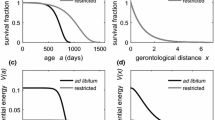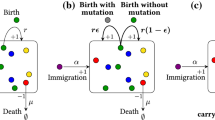Abstract
Deterministic descriptions of dynamics of competing species with identical carrying capacities but distinct birth, death, and reproduction rates predict steady state coexistence with population ratios depending on initial conditions. Demographic fluctuations described by a Markovian birth-death model break this degeneracy. A novel large carrying capacity asymptotic theory confirmed by conventional analysis and simulations reveals a weak preference for longevity in the deterministic limit with finite-time extinction of one of the competitors on a time scale proportional to the total carrying capacity.





Similar content being viewed by others
References
Hardin, G.: The competitive exclusion principle. Science 131, 1292–1297 (1960)
Gause, G.F.: The Struggle for Existence. Williams & Wilkins, Baltimore (1934)
Hutchinson, G.E.: The paradox of the plankton. Am. Nat. 95, 137–145 (1961)
Cushing, J.M., Levarge, S., Shitnis, N., Henson, S.M.: Some discrete competition models and the competitive exclusion principle. J. Differ. Equ. Appl. 10, 1139–1151 (2004)
Doering, C.R., Sargsyan, K.V., Sander, L.M.: Extinction times for birth-death processes: exact results, continuum asymptotics, and failure of the Fokker-Planck approximation. SIAM J. Multiscale Model. Simul. 3, 283–299 (2005)
Parker, M., Kamenev, A.: Mean extinction time in predator-prey model. J. Stat. Phys. 141, 201–216 (2010)
Mangel, M., Ludwig, D.: Probability of extinction in a stochastic competition. SIAM J. Appl. Math. 33, 256–266 (1977)
Kurtz, T.G.: Solutions of ordinary differential equations as limits of pure jump Markov processes. J. Appl. Probab. 7, 49–58 (1970)
Kurtz, T.G.: Limit theorems for sequences of jump Markov processes approximating ordinary differential processes. J. Appl. Probab. 8, 344–356 (1971)
Katzenberger, G.S.: Solutions of a stochastic differential equation forced onto a manifold by a large drift. Ann. Probab. 19, 1587–1628 (1991)
Parsons, T.L., Quince, C.: Fixation in haploid populations exhibiting density dependence II: The quasi-neutral case. Theor. Popul. Biol. 72, 468–479 (2007)
Parsons, T.L., Quince, C., Plotkin, J.B.: Absorption and fixation times for neutral and quasi-neutral populations with density dependence. Theor. Popul. Biol. 74, 302–310 (2008)
Durrett, R., Popovic, L.: Degenerate diffusions arising from gene duplication models. Ann. Appl. Probab. 19, 15–48 (2009)
Hastings, A.: Can spatial variation alone lead to selection for dispersal? Theor. Popul. Biol. 24, 244–251 (1983)
Dockery, J., Hutson, V., Mischaikow, K., Pernarowski, M.: The evolution of slow dispersal rates: a reaction diffusion model. J. Math. Biol. 37, 61–83 (1998)
Kessler, D.A., Sander, L.M.: Fluctuations and dispersal rates in population dynamics. Phys. Rev. E 80, 041907 (2009)
Waddell, J.N., Sander, L.M., Doering, C.R.: Demographic stochasticity versus spatial variation in the competition between fast and slow dispersers. Theor. Popul. Biol. 77, 279–286 (2010)
Lin, Y.T.: Ph.D. Dissertation, University of Michigan (2013, to appear)
Acknowledgements
This research was supported by NSF Awards PHY-0855335 and DMS-0927587. HK and CRD acknowledge the hospitality of NSF’s Institute for Mathematics and Its Applications at the University of Minnesota where the project was started. We are grateful to Baruch Meerson and Michael Khasin for bringing Refs. [11] and [12] to our attention after completion of this work but prior to submission of this manuscript.
Author information
Authors and Affiliations
Corresponding author
Appendices
Appendix A: Advantages and Extinction Times for Finite K
Several statistical features of the competition process are quantitatively enhanced at finite carrying capacity relative to their magnitudes at infinite carrying capacity. In this appendix we present some of the simulation data at finite K to illustrate these effects.
Figure 6 is a plot of the probability of domination of the Y-species over the X-species starting from position z on the coexistence line for life-cycle ratio γ=10, so that X is the quick-to-reproduce and quick-to-die species. The probability that the slow-species wins the competition is evidently a decreasing function of the carrying capacity K, and at low K the slow-species’ competitive advantage is significantly amplified relative to that in the K→∞ limit.
Probability of domination of the (slow) Y-species over the (fast) X-species starting from position z on the coexistence line for life-cycle ratio γ=10 and carrying capacities K=12,50,200,1000 (discrete data top to bottom) as a function of starting position z on the coexistence line. The discrete data are from 104 independent simulations, and the solid line (barely visible under K=1000 data) is the K→∞ prediction for u(z) from Eq. (27) or (47) (Color figure online)
Moreover, the mean time that it takes for one or the other species to go extinct, i.e., the time it takes to determine the winner of the competition, is significantly shorter at finite carrying capacity. Figure 7 is a plot of the mean extinction time \(m(z) =\mathrm{E} \{ \tau(z) \}\) of one species or the other starting from position z on the coexistence curve, normalized by K, for equal life-cycle time scales, γ=1, and various values of K varying from 12 (bottom data set) to 1000 (top data set). The solid line, barely visible under the high-K data, is the K→∞ asymptotic prediction. Evidently, when time is measured in units proportional to K, the mean extinction time increases monotonically with K.
Mean extinction time \(m(z) = \mathrm{E} \{ \tau(z) \}\) of one species or the other starting from position z on the coexistence curve for γ=1, ρ=2, and several values of the carrying capacity K. The solid lines is the high-K theoretical prediction and the discrete data are from 104 independent simulations (Color figure online)
Figure 8 shows the mean extinction time \(m(z)=\mathrm{E}\{\tau(z)\}\) of one species or the other starting from position z on the coexistence curve, normalized by K, for life-cycle time scale ratio γ=50 and K varying from 12 (bottom data set) to 1000 (top data set). In this example the fast-living X-species lives and dies on a time scale 50 times greater than that of the Y-species. The solid line at the top is the K→∞ asymptotic prediction. Again, when time is measured in units proportional to K, the mean extinction time increases monotonically with K at each value of z. The data indicate that the rate at which one or the other species vanishes at lower values of K is exaggerated even more at extreme values of γ.
Mean extinction time \(m(z) = \mathrm{E} \{ \tau(z) \}\) of one species or the other starting from position z on the coexistence curve for γ=50, ρ=2, and several values of the carrying capacity K. The solid lines is the high-K theoretical prediction and the discrete data are from 104 independent simulations (Color figure online)
Furthermore, the data presented in Figs. 6, 7, and 8 are also consistent with the algebraic convergence of the probability of domination of the Y-species over the X-species and the normalized mean extinction time (m(z)/K) to their K→∞ limits. That is, if one is willing to look past the statistical fluctuations, the differences between the finite-K data and the infinite-K theoretical predictions are, pointwise in z, consistent with \(\mathcal{O}(1/K)\) convergence. This is in accord with the ansatz adopted for the conventional asymptotic analysis in Sect. 3 for γ=1, and in Appendix B for arbitrary γ.
Appendix B: Perturbation Analysis for Arbitrary γ
In this appendix we show how to extract the leading order equation for the mean exit time from the first quadrant in the general case γ≠1. The boundary value problem is
where the backward Kolmogorov operator L≡ϵ 2 L 0+L 1 contains with
and
Inserting the asymptotic ansatz T∼ϵ −2 T 0+T 1+ϵ 2 T 2+⋯ implies, order by order, that the T n satisfy



Now transform the problem into coordinates (κ,μ) defined by
This transformation is a one-to-one mapping of the open first quadrant into itself, and the degenerate coexistence manifold is the set {κ=1,0<μ<∞}. The important point is that the coordinate μ is constant on deterministic trajectories defined by the drift. In these new coordinates the operators are


where we refer to the inverse mapping from (κ,μ) back to (x,y) by


remarking that, at least for the leading asymptotic approximation of the mean first passage time, the explicit forms of these functions are irrelevant.
The leading equation 0=L 1 T 0 implies 0=∂ κ T 0 so that T 0 is a function of μ only. Then the next (inhomogeneous) equation −1=L 0 T 0+L 1 T 1 is

This is valid throughout the first quadrant of the (κ,μ) plane, and in particular on the coexistence line κ=1 where L 1 vanishes implying
Now transform to the variable z=x−y, noting that
is a monotone function of z on the coexistence line. After some algebra (61) becomes
from which the drift (45) and diffusion (46) on the coexistence line may be read off.
Rights and permissions
About this article
Cite this article
Lin, Y.T., Kim, H. & Doering, C.R. Features of Fast Living: On the Weak Selection for Longevity in Degenerate Birth-Death Processes. J Stat Phys 148, 647–663 (2012). https://doi.org/10.1007/s10955-012-0479-9
Received:
Accepted:
Published:
Issue Date:
DOI: https://doi.org/10.1007/s10955-012-0479-9







